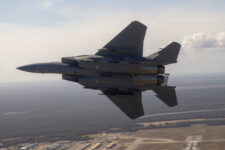
Bill Greenwalt argues the US needs to increase its current level of defense spending by 3% to 5% a year in real terms, because China, our principal geostrategic competitor, is already outspending us on defense and time is not on our side.
Greenwalt comes to this conclusion by claiming that in estimating the size of the Chinese defense budget, we should not rely on the analysis by such internationally recognized groups as the Stockholm Peace Research Institute (SPRI) or the International Institute for Strategic Studies (IISS), but instead use Purchasing Power Parity (PPP.) On top of that, he says that, when analyzing the size of the US defense budget, we need to eliminate all the money the Pentagon supposedly spends on social programs. Therefore, he concludes that the annual military budget analysis of IISS that the US spends more on defense than the next 13 countries in the world combined, is a trope.
But close analysis demonstrates that all of these claims are misleading at best and present a distorted picture of our military spending and that the defense budget of $753 billion, proposed by the Biden administration, for 2022 is more than enough, even though it does not call for a real increase in the level of defense spending over last year’s.
In arguing that the Chinese defense budget is actually more than double the SPRI number, Greenwalt employs the same methodology that the defence hawks used in the Cold War. I saw this myself during my early days in the Reagan Pentagon. As we prepared our first defense budget for 1982, and as someone responsible for manpower issues, I argued that we needed to give our troops an across the board increase of 14.3% in their base pay in our upcoming budget. Not surprisingly some of my colleagues in the Pentagon and OMB argued that this amount was too large.
To deal with this argument, I made two points. First, 14.3% was the gap between what the Employment Cost Index (ECI) demonstrated that the troops should be receiving and what they were actually getting. Consequently, we were having a difficult time in recruiting and retaining a sufficient number of qualified men and women to volunteer for military service.
Second, by giving our troops this large a raise, we would increase the gap between our defense budget and that of the Soviet Union. Since the Soviets did not have a normal economic system, the CIA’s annual estimate of Soviet military spending calculated how much it would cost us to purchase and maintain the same size force.
In essence, the CIA was using what today we would call PPP to compare the budgets of the two superpowers, a concept that Bill Greenwalt uses to raise the Chinese budget from the SPRI amount of between $184 billion and $252 billion to $518 billion. Therefore, increasing the pay for our force, which was smaller than that of the Soviet Union, would widen the gap and make it politically easier for Reagan to sell his massive defense budget build up. My boss, Secretary Weinberger, who ran OMB for Nixon, quickly dropped his objections to the proposed raise when I presented the case in that manner.
We got the large increase in pay for the troops, which helped save the All Volunteer Force (AVF), and this helped Reagan get a massive increase in defense spending in his first administration. But, even with this increase, we never matched the CIA estimate of Soviet military expenditures. Moreover, even after the massive deficit President Reagan ran up in his first term forced him to cut defense spending by 10% (in real dollars) in his second term, we still somehow won the Cold War.
Not only does Greenwalt argue that the Chinese budget is really more than twice as large as the official estimate, but that there are about $200 billion of non-defense items embedded in the US defense budget such as health care and grocery stores. This argument also fails on at least two accounts
First, most of the items that he, the late Sen. John McCain and current Rep. Anthony Brown, claim should not be part of the defense budget actually should be. For example, the total compensation package for military personnel includes free health care as well as low-cost groceries at commissaries and exchanges for them and their dependents not only while they are on active duty, but when they retire. If DoD did not fund these, basic pay would have to be increased dramatically
In addition Greenwalt’s analysis ignores the fact that there are significant expenditures outside of the annual defense budget that could and should be part of it. For example, the US Treasury Department currently spends over $100 billion a year on the amortization of unfunded liabilities in the military retirement and healthcare funds, which until the mid 1980s were funded annually by the Department of Defense. It was moved out of the defense budget by Congress on the condition that the Pentagon would reduce the retirement amount from 50% to 40% for those eligible for retirement pay. However, after a decade the Pentagon returned to 50%, giving DoD the best of both worlds and letting Treasury pick up the bill.
Similarly, much of the $260 billion annual budget of the Veterans Administration (VA) goes for items like health care for military retirees and education benefits, which is an excellent recruiting tool, and also saves the Pentagon substantial sums.
While the US, as Greenwalt points out, spends 16 times as much on its military recruits as China, are not our troops much better than their Chinese counterparts, who receive an average of $30,000 a year, which is less than half of what our troops get? Moreover, even with our smaller budget, the US has 20 times the number of nuclear warheads as China, three times the number of modern fighter jets, twice the tonnage of warships at sea, three times as many modern fighter jets, 800 overseas bases compared to China’s 3, and spends twice as much of GDP on defense as China.
Even if one accepts Greenwalt’s argument that the claim that the US spends more then the next 13 countries in the world combined is a trope, the fact of the matter is that most of those other countries on the list are US allies or friendly countries.
A much better comparison for determining whether we need to increase or decrease defense spending is to compare, in real terms, what we spent during the Reagan buildup or the peaks of the Korea and Vietnam Wars to our current level. Doing so shows that $753 billion, which is the proposed budget of the Biden administration for 2022, is substantially higher. While there is no doubt that Chinese military power is increasing, it is still nowhere close to that of the former Soviet Union, and somehow we won the Cold War even though the Soviets theoretically outspent us.
Moreover, the Reagan defense buildup was needed because of the severe cuts in defense spending in the 1970s, primarily by the Nixon administration. Biden is inheriting a defense budget that Trump increased by $100 billion over his four years in office. The Pentagon’s problems are not the amount of money it receives but how it spends it.
Lawrence Korb, a senior fellow at the Center for American Progress, served as an assistant Defense Secretary for four-and-a-half years in the Reagan administration.






















